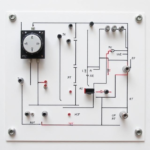Phasor Representation and Complex Numbers in AC Circuits
In alternating current (AC) circuit analysis, the behavior of sinusoidal voltages and currents can be complex due to their time-varying nature. To simplify analysis, engineers commonly use phasors and complex numbers—mathematical tools that transform sinusoidal waveforms into manageable, steady-state quantities.

What Is a Phasor?
A phasor is a complex number that represents a sinusoidal waveform—like voltage or current—as a rotating vector in the complex plane.
A typical sinusoidal voltage is written as:
Where:
-
= Peak voltage
-
= Angular frequency in radians/second
-
= Phase angle
-
= Time
In phasor form, this becomes:
Where:
-
= Root Mean Square value
-
= Phase angle
Phasor notation transforms a time-varying signal into a constant vector, simplifying circuit analysis.
Why Use Phasors?
Phasors convert differential equations into algebraic equations, allowing easier manipulation of sinusoidal AC signals. Key advantages include:
-
Simplified operations: Addition, subtraction, multiplication, and division become straightforward.
-
Vector visualization: Phasors show both magnitude and phase.
-
Efficient analysis: Engineers can analyze circuits using basic algebra instead of calculus.
Complex Numbers in AC Circuit Analysis
Phasors are expressed using complex numbers, which have both real and imaginary components:
Rectangular Form:
Where:
-
= Real part
-
= Imaginary part
-
= Imaginary unit (; is used in electrical engineering to avoid confusion with current, )
Polar Form:
Where:
-
= Magnitude
-
= Phase angle (in degrees or radians)
This representation is key to describing voltages, currents, and impedances in AC systems.
Application: Complex Impedance of Circuit Elements
Every passive component in an AC circuit has a complex impedance , which relates voltage and current phasors using Ohm’s Law:
Impedances:
-
Resistor: (purely real)
-
Inductor: (positive imaginary)
-
Capacitor:
(negative imaginary)
Where:
-
: Angular frequency
-
: Frequency in Hz
These expressions allow for uniform treatment of different components using phasor algebra.
Benefits of Phasor and Complex Number Analysis
| Operation | Phasor Advantage |
|---|---|
| Addition/Subtraction | Simple vector (complex number) arithmetic |
| Multiplication/Division | Easy magnitude and phase handling |
| Solving AC Circuits | Replaces calculus with basic algebra |
| Power Calculations | Real, reactive, and apparent power directly accessible |
Summary Table
| Concept | Description | Why It’s Useful |
|---|---|---|
| Phasor | Rotating vector representing a sinusoidal signal | Converts AC waveforms into steady-state vectors |
| Complex Number | Number with real and imaginary parts | Enables algebraic manipulation of AC quantities |
| Impedance (Z) | Complex form of resistance and reactance | Uniformly models resistors, capacitors, and inductors |
| Phasor Algebra | Use of complex number rules for AC operations | Simplifies circuit analysis and power calculations |
Conclusion
Phasor representation and complex numbers are essential tools in AC circuit analysis. They turn time-domain problems into steady-state solutions, making the design, analysis, and troubleshooting of AC systems significantly more efficient and intuitive.










